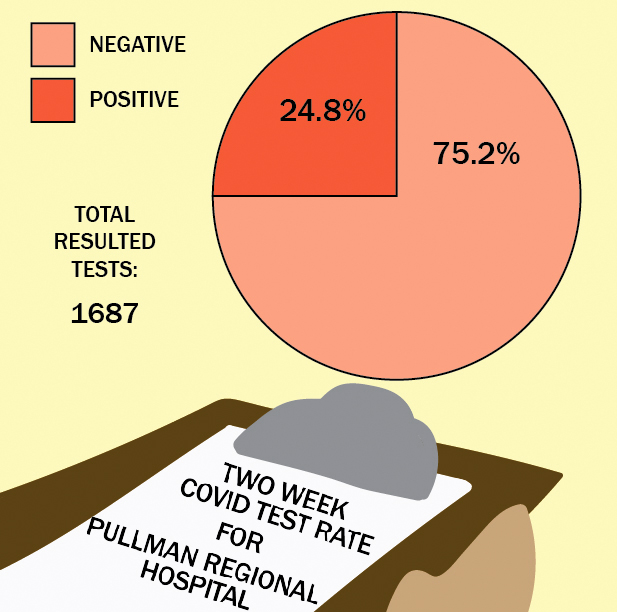Drastic spike of COVID-19 cases impacts local hospital’s testing process
Patients perform nasal swabs themselves; wait time for test results is 24 to 48 hours
From Aug. 19 to Sept. 1, Pullman Regional Hospital conducted 1,687 COVID-19 tests, and 418 results were positive. PRH conducted an average of 121 tests per day.
September 9, 2020
Pullman Regional Hospital increased its testing in its COVID-19 Testing Center due to the return of WSU students in the community.
The drive-thru center, which is a trailer situated at the back of PRH near its emergency department entrance, opened in March to keep possible COVID-19 patients outside of the hospital, said Stephanie Knewbow, PRH emergency department director and registered nurse.
The center was closed during the summer because the number of positive COVID-19 cases at the time was fairly low. She said the testing center reopened on Aug. 21, which was three days before WSU’s fall semester started, as a response to the increase of cases in the county.
On Aug. 21, the center saw more than 30 patients in a few hours after it opened. That weekend, the center conducted about 60 tests per day, she said.
“By the next week, we were up in the 80s, 90s,” Knewbow said. “I think 130 had been the most we’ve seen in the trailer in one day.”
From Aug. 19 to Sept. 1, PRH conducted a total of 1,687 COVID-19 tests, and 418 of those tests were positive. PRH conducted an average of 121 tests per day during that period with a 24.8 percent positivity rate, according to PRH’s website.
Knewbow said the center has to adapt all the time because the county’s positive COVID-19 cases continue to rise. As of Tuesday, Whitman County has a total of 844 positive COVID-19 cases, according to a press release from the Whitman County Emergency Operations Center.
“We’re reacting to the spike,” said Megan Guido, PRH chief marketing and community relations officer. “We have limited resources and staff at a small hospital, but we’re managing things well.”
Individuals without a doctor’s order can get tested from 11 a.m. to 5 p.m. any day of the week and will be charged a minimum of $225 to their insurance, Guido said.
There are financial options available to those who do not have insurance, she said. PRH may provide discounts or cover the cost of the test through some CARES Act funding the hospital received.
Those who have a doctor’s order can get tested from 10 a.m. to 2 p.m. Mondays through Saturdays, Guido said. They will be charged $100.
Knewbow said there are COVID-19 Testing Center parking signs to direct people where to park. Individuals should notify the testing center staff of their arrival by calling the number posted on the signs.
A person will then fill out a registration form. After registration, a physician will meet with the patient at the parking lot. A nurse will take the patient’s vitals. Testing center staff will also ask individuals how they were exposed and what COVID-19 symptoms they have.
“If our patient looks too sick for our drive-in, we’re going to encourage those patients to come in and get evaluated inside the ER, or if the doctors feel like they can’t treat them out in the parking lot,” Knewbow said.
Patients will perform the nasal swabs themselves, she said, to present fewer risks to the testing center’s staff. Staff will give patients an instructional paper that explains how patients can swab themselves. Patients will then put their swab in a tube, which is taken to the hospital’s lab.
Guido said patients can access their test results through the PRH’s patient portal. At the testing center, staff will present a pamphlet to patients that explains how to sign up on the portal.
The average wait time for test results is 24 to 48 hours, she said.
Two nurses, a certified nursing assistant, a physician and another staff member typically work at the center every day, Knewbow said. Other hospital staff might help at the center, depending on how many patients are at the testing site.
“A lot of the staff are already working full-time, so you’re just working overtime to help cover the trailer,” she said. “Just finding enough people to work it … to see all the patients coming have been the hard part of it.”
Knewbow said individuals should wear masks, practice social distancing, and stay home as much as possible.
“All those little things will really help if we can stick by them,” she said.












Kat Jackson • Sep 10, 2020 at 4:14 pm
I went there for a pre-surgery Covid test on a Tuesday at 1:30..completely empty Covid testing lot.